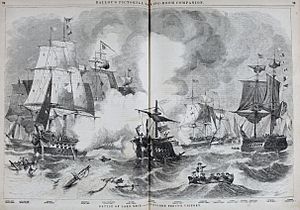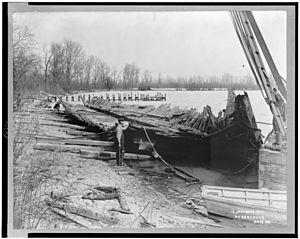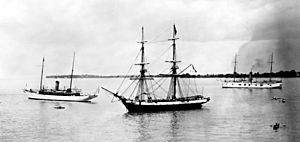USS Niagara (1813) facts for kids
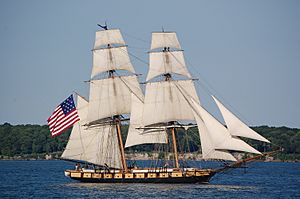
US Brig Niagara near Put-in-Bay, Ohio in June 2009
|
|
Quick facts for kids History |
|
|---|---|
| Name | Niagara |
| Owner | Pennsylvania Historical and Museum Commission |
| Ordered | 31 December 1812 |
| Launched | 13 June 1813 |
| Sunk | 1820 |
| Raised | 6 March 1913 |
| Restored | 1913, 1931–1943, 1963, 1988 |
| In service | Restoration |
| Homeport | Erie, Pennsylvania |
| Status | Museum ship under restoration |
| General characteristics | |
| Class and type | Niagara-class snow-brig |
| Displacement | 297 long tons (302 t) |
| Length | 110 ft 8 in (33.7 m) LBP |
| Beam | 32 ft (9.8 m) |
| Height |
|
| Depth | 9 ft (2.7 m) |
| Sail plan | 12,665 sq ft (1,177 m2) on two masts |
| Boats & landing craft carried |
2 cutters, 1 yawl |
| 1813: | |
| Tons burthen | 492 60⁄95 tons |
| Complement | 155 officers and enlisted |
| Armament |
|
| 1998: | |
| Tonnage | 162 GT |
| Installed power | 2 × 200 bhp (150 kW) diesel engines |
| Crew | 20 professional, 20 volunteer |
| Armament | 2 × 32-pounder carronades |
|
U.S.S. Niagara
|
|
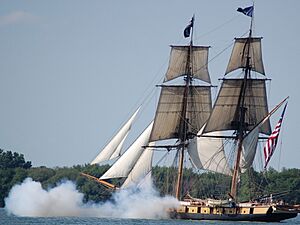
Brig Niagara firing its cannons, off of Put-in-Bay, Ohio
|
|
| Location | Erie, Pennsylvania |
| Area | Less than one acre |
| Architectural style | Snow-brig |
| NRHP reference No. | 73001628 |
| Significant dates | |
| Added to NRHP | 11 April 1973 |
| Designated NHL | 11 April 1973 |
The USS Niagara is a famous wooden ship that played a big part in American history. It's often called the U.S. Brig Niagara or the Flagship Niagara. This ship was the backup flagship for Oliver Hazard Perry during the important Battle of Lake Erie in the War of 1812.
Today, the Niagara is used for sail training and is called SSV Niagara. You can usually find it docked behind the Erie Maritime Museum in Erie, Pennsylvania. In the summer, it often sails around the Great Lakes, acting as an ambassador for Pennsylvania. The Niagara was added to the National Register of Historic Places in 1973 and became Pennsylvania's official state ship in 1988.
The Niagara was built between 1812 and 1813 to protect the American coastline on Lake Erie from British attacks. It was very important in the battle for control of the lake. Like many warships from that time, the Niagara was sunk in 1820 to help preserve it. It was raised in 1913 and rebuilt for the 100-year anniversary of the Battle of Lake Erie. Over the years, it has been restored several times, with a big restoration in 1988. Because so much of the ship has been rebuilt with new materials, some people wonder if it's still the "original" ship or more of a replica.
Contents
Building a Warship
In September 1812, a merchant named Daniel Dobbins warned the U.S. government that the Lake Erie coastline was open to British attacks. Dobbins had been captured by the British but managed to get free. He convinced President James Madison and the Secretary of the Navy, Paul Hamilton, that the safest place to build a fleet of ships was in the protected bay at Erie, Pennsylvania.
Hamilton gave Dobbins permission to build four gunboats and later two larger ships called brigs. Oliver Hazard Perry was put in charge of the naval forces in Erie in February 1813.
The building of these ships was mostly overseen by Noah Brown, a skilled shipbuilder from New York City. The main beams, called keels, for the two brigs were made from huge black oak logs. Because iron was scarce, wooden pins called treenails were used to join the timbers. Instead of the usual sealing materials, lead was used to seal the gaps in the ship's hull. The wood used was still "green" or fresh, as there wasn't enough time to let it dry properly.
Many cannons were sent to Erie to arm the fleet. The brig Niagara was launched on July 4, 1813.
One clever thing about building the fleet in Erie was that the bay was separated from Lake Erie by a sandbar. This sandbar stopped British warships from getting into the bay. However, the Niagara and another brig, the Lawrence, were too deep to cross the sandbar easily. On August 4, the Niagara was pulled over the sandbar using a special technique. Its cannons and heavy ballast were removed to make it lighter. Large barges were placed on either side of the ship, filled with water, and then pumped dry to lift the ship over the sandbar. By the next day, the Niagara was safely across and rearmed. The British often watched the area but didn't notice Perry's plan to move the ships.
The War of 1812
On August 6, Perry ordered his fleet, which now included ten ships, to go on a practice cruise. Jesse Elliott was given command of the Niagara on August 10.
Perry's fleet met with General William Henry Harrison and his soldiers. Harrison provided 100 riflemen to serve as Marines on the ships. The British fleet, led by Commodore Robert Heriot Barclay, was based in Canada. They were running low on supplies because Perry's fleet had cut off their shipments. So, Barclay's fleet set sail as soon as their new ship, the Detroit, was ready.
The Battle of Lake Erie
On September 10, 1813, both fleets began to fight. The Detroit fired first. Perry arranged his ships in a line, with each large ship targeting a British ship. The Lawrence was meant to fight the Detroit, and the Niagara was to fight the Queen Charlotte.
During the battle, the Niagara, under Elliott's command, fell behind the rest of the fleet. It's not clear why this happened. After a couple of hours, the Lawrence was badly damaged and couldn't be steered. Perry famously took down his battle flag, which said "Don't Give Up The Ship", and transferred to the undamaged Niagara in a small boat.
Perry took command of the Niagara and sailed it directly through the British line. The Queen Charlotte crashed into the Detroit while trying to stop the Niagara. The Niagara then fired its cannons from both sides. One side hit the Queen Charlotte and Detroit, and the other hit the Lady Prevost. After several powerful shots, the Queen Charlotte surrendered, and soon after, the Detroit and the rest of the British fleet also gave up.
After this important victory, the Niagara helped transport Harrison's army to the Detroit River to prepare for an invasion of Canada. In 1814, the Niagara was part of a fleet that sailed to Mackinac Island for another battle, which the Americans lost.
When the Treaty of Ghent was signed, ending the war, most of the surviving ships from the Battle of Lake Erie were sunk for preservation in 1815. The Niagara was kept afloat for a while but was also sunk in 1820 when the naval station closed. Later, in 1836, a man named George Miles raised the ships, hoping to use them for trade. However, the Lawrence and Niagara were in poor condition and sank again.
Bringing the Ship Back to Life
For the 100-year anniversary of the Battle of Lake Erie, the Niagara was raised from Misery Bay in April 1913. Its main beam, the keel, was in good enough shape to rebuild the ship. Since there were no original plans, rebuilding the Niagara was difficult. The restored Niagara was launched on June 7, 1913, with new parts and cannons. From July to September, the Niagara was towed to different ports on the Great Lakes, including Milwaukee, Chicago, and Cleveland.
In 1917, the City of Erie took ownership of the Niagara, but it slowly started to fall apart. In 1929, a group called the "USS Niagara Foundation" was formed to restore the ship. However, the Great Depression made it hard to get money, so the state of Pennsylvania took over in 1931. Another restoration began, but funding stopped in 1938, leaving it unfinished.
The Niagara became a project for the Works Progress Administration. A ship designer named Howard I. Chapelle drew up new plans based on other ships built by Noah Brown. Chapelle found that very little of the original Niagara was left. The hull of the Niagara was launched in October 1943, but without its masts or rigging. In 1951, it was placed in a concrete support structure. When dry rot was found everywhere, it became clear that a complete rebuild was needed. Funds were given to make the Niagara look good for the 150-year anniversary of the Battle of Lake Erie in 1963. The Niagara was officially listed on the National Register of Historic Places on April 11, 1973.
The Museum Ship Today
In 1981, the Flagship Niagara League was created. Their goal was to rebuild the Niagara so it could actually sail again, not just be a museum display. Melbourne Smith, a famous shipbuilder, was hired in 1986 to lead the reconstruction. The old Niagara was in such bad shape that it was taken apart and mostly replaced. Only some timbers were saved and used in non-structural parts. This is why many people consider the current Niagara to be a replica. The new Niagara was built with carefully dried and preserved wood.
The new Niagara was launched on September 10, 1988, and finished its sea trials on July 18, 1990. On April 29, 1988, the Pennsylvania General Assembly named the Niagara the official flagship of Pennsylvania, meant to be a "sailing ambassador." In March 2008, the mainmast was replaced with a new one.
The United States Coast Guard certified the Niagara as a Sailing School Vessel in August 2005. For safety, the ship was given modern equipment like diesel engines, lifeboats, radar, and radio. In 2009, the Flagship Niagara League took over daily management of the ship.
For the 200-year anniversary of the Battle of Lake Erie, the Niagara took part in a reenactment of the battle on September 2, 2013, along with 16 other tall ships.
In December 2023, the Pennsylvania Historical and Museum Commission announced they would take over running the Niagara from the Flagship Niagara League, focusing more on its role as a museum ship. In April 2024, the United States Coast Guard declared the Niagara inactive and closed it to the public for a time. In July 2024, Greg Bailey became the ship's new captain. The ship was sailed to Cleveland for mechanical work in late 2024. The ship arrived in Boothbay Harbor, Maine in June 2025 for a major upgrade. The goal is to return the vessel to Erie by July 2026 to celebrate the 250th anniversary of the United States.
See also
- List of Pennsylvania state symbols
- National Register of Historic Places listings in Erie County, Pennsylvania
Images for kids


